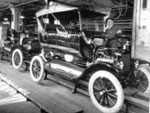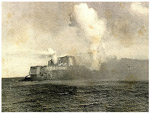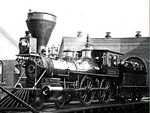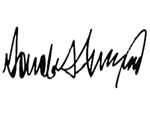The American Skyscraper: Transforming Chicago and the Nation
No details provided.
No details provided.
No details provided.
Historian Anthony Sammarco follows the development of downtown Boston from the city's early years to the present day. He focuses on the area called Downtown Crossing, following the Great Boston Fire of 1872, and examines the commercial shopping establishments that replaced pre-fire residences and churches. His presentation includes slides.
This feature is no longer available at WGBH.
In this Face-to-face Talk, Ann Shumard of the National Portrait Gallery details the life of Samuel Morse (17911872), including his early interest in portraiture and art, his career as an inventor and his work on the telegraph, and his support of Louis Daguerre's daguerreotype.
This lecture is a repeat of node identification number 21992.

What pushes and pulls people into new ways of life? In this lesson, students use artifacts, documents, and photographs to help them answer this question.
The Henry Ford Museum’s "Early 20th Century Migration—Transportation: Past, Present and Future" is a thematically rich teaching unit. Through artifacts, documents and photographs, students explore the overarching question, What pushes and pulls people into new ways of life? How did the lure of jobs in U.S. factories “pull” Europeans and people of the American South to northern cities and new ways of living? The lessons are both rigorous and relevant, and continuously engage students in considering the impact of the past on the present.
Dubbed an Educator DigiKit, the unit includes extensive materials for teachers. The Teacher’s Guide includes timelines on various historic themes relevant to the lesson topics, a glossary, bibliographies, connections to Michigan and national standards, and field trip suggestions. The lesson plans introduce the assembly line concept, technological and economic forces that cause large-scale migration, fair labor issues, challenges faced by immigrants, and the ongoing changing nature of work up to the present. All of the lessons include links to primary sources in the Henry Ford Museum Online Collection and they utilize a range of activities, including simulations, math-based problem solving, and source analysis.
Teachers will want to consider supplementing this unit by incorporating a rigorous, systematic approach to analyzing primary sources. Borrowing one from another site (see possibilities here) could strengthen the individual lessons and unit. A rich resource, 20th Century Migration honors middle elementary children by challenging them to ponder and interpret significant topics in history that continue to affect their world today.

Yes
Not only are the details accurate, but the breadth of the perspectives in the lessons helps students develop an accurately complex sense of the unit topics.
Yes
Brief secondary sources provide context for the investigations. For examples, see an essay on the nature of assembly line work on page 44, or a PowerPoint on urbanization that is linked from pages 36 or 37.
Yes
Includes a few explicit writing exercises, primarily short-answer assessments. Class discussion questions might be used as writing prompts in older grade levels.
For an example, see writing prompts for primary source analysis on page 55.
Yes
Would have liked to see primary source analysis embedded earlier in the unit; it is not introduced until near the end of the unit. The unit would also be more powerful if it introduced a systematic model for source analysis.
No
The source analysis guides do not ask students to consider the author or creator of a source. The informal mini-biographies used as primary sources in Lesson 6 are intriguing; the lesson would help students better understand the nature of historical analysis if they engaged them in asking who created the biographies and why.
Yes
The lessons lend themselves to ready adaptation not only in grades 3-5, but for middle school as well.
Yes
Yes
Topical knowledge is emphasized in the unit. Nonetheless, the unit does include activities to engage children in interpreting historical documents for basic understanding. No criteria for assessment are included.
Yes
The learning goals are topical.
Yes
The learning goals are topical.

Visitors to this site will find more than 1,000 images and dozens of videos about the history and culture of Puerto Rico. The work of dozens of scholars and contributors, the Puerto Rico Encyclopedia reflects the diverse nature of the island: a U.S. territory, a key location for trade in the Caribbean, a Spanish-speaking entity with its own distinct culture, and a part of a larger Atlantic world. Funded by an endowment from the National Endowment for the Humanities and the Fundación Angel Ramos, the site is a key product from the Fundación Puertorriqueña de las Humanidades. It provides users with all content in both English and Spanish. Educators will find the site easy to navigate and conveniently categorized by themes; within each topic, appropriate subtopics provide an in-depth examination of Puerto Rican culture and history. Of particular interest to U.S. History teachers are the images and information found under History and Archeology. Here, teachers and students can explore a chronological narrative of the island's history and role at specific moments in U.S. and Atlantic history. Other sections worth exploring are Archeology (for its focus on Native American culture), Puerto Rican Diaspora (for its look at Puerto Ricans in the U.S.), and Government (for a detailed history on Puerto Rico's unique status as a free and associated US territory). Educators in other social science courses will also find valuable information related to music, population, health, education, and local government. In all, 15 sections and 71 subsections provide a thorough examination of Puerto Rico. The Puerto Rico Encyclopedia's bilingual presentation also makes it a good site for integrating Hispanic culture into the U.S. History curriculum, as well as helping to bridge curriculum for English Language Learners (ELLs) in the classroom.

How did railroads affect the political systems in 1870-1914?
Railroads and the political system have been intertwined since the first rail systems in the 1830s and 1840s when in the name of “internal improvements” the Whig Party supported government funding for start-up railroad companies. It was, however, during its rapid expansion in the post-Civil War era that the industry’s ties to the political system became controversial.
The federal government gave railroad companies thousands of acres of land on which to run their tracks. Men like Jay Gould, Cornelius Vanderbilt, E. A. Harriman, James J. Hill, and J.P. Morgan controlled a powerful industry. They wielded political power, too, by demanding the federal government send troops in to break up railroad strikes in 1877 and 1894. Meanwhile farmers began to protest the railroad’s monopoly over transportation rates. Congress responded with the Interstate Commerce Act (1887), which sought to prevent “pools” of interests from dominating industries. But given that both Republican and Democratic leaders benefited from gifts given by the railroad companies, real reform, it seemed, was going to have to come from outside the two-party system.
The People’s Party, or the Populists, emerged in the 1890s calling for strict regulation to rein in railroad companies’ power. By the early 1900s, self-styled “progressives” in both parties had picked up on the Populists’ and organized labor’s attacks on the railroads. During Theodore Roosevelt’s presidency, progressive Republicans and Democrats joined forces to pass the Elkins Act (1903), the Hepburn Act (1906) and, during William Howard Taft’s term as president, the Elkins-Mann Act (1910) and the Railroad Valuation Act (1913) all of which regulated the industry. Conservative Republicans pushed back by denying Roosevelt the nomination in 1912, thus causing a rift in the party and guaranteeing Woodrow Wilson’s election.
Central Pacific Railroad Photographic Museum Connolly, Michael J. Capitalism, Politics, and Railroads in Jacksonian New England (Columbia: University of Missouri Press, 2003). Martin, Albro. Railroads Triumphant (Oxford: Oxford University Press, 1992). Stover, John F. American Railroads (Chicago and London: The University of Chicago Press, second edition, 1997). Summers, Mark W. Railroads, Reconstruction, and the Gospel of Prosperity (Princeton, New Jersey: Princeton University Press, 1984.
Martin, Albro. Railroads Triumphant (Oxford: Oxford University Press, 1992).
The National Atlas of the United States of America. "Presidential Elections 1908-1920." Last modified August 03 2010.

Using the premise of a mystery to solve, elementary students act as history detectives as they explore a historical question and analyze carefully chosen clues to formulate and test hypotheses.
This strategy depends on our need to solve mysteries. Students are given an opportunity to be active learners as they solve a historical mystery. This strategy relates to what historians do and the process of historical inquiry. Students must work with evidence, form hypotheses, test those hypotheses, and report their findings.
The goals of the mystery strategy are to learn to: 1. gather, organize, and process information; 2. formulate and test hypotheses; 3. think creatively and analytically to solve problems; and 4. develop, defend, and present solutions to problems.
1. Choose an topic that contains a mystery such as “Why did the American beaver almost become extinct in the 1840s?” Other examples of appropriate historical mysteries include: “How did flooding in Mississippi in 1931 hinder the Civil Rights Movement?”; “Who really invented the cotton gin?”; and “Was the Boston Massacre really a massacre?”
2. Gather primary and secondary sources that will serve as clues for students such as letters, diary entries, maps, statistical tables, political cartoons, images, artifacts for students to touch (in this case beaver fur or felt), and web articles. These sources should pique students’ interest and provide them with clues that will help them generate theories. For example, if students are given a clue regarding the habitat and species characteristics of the beaver and then also told John Jacob Astor was the wealthiest man in America in 1848 it is hoped they conclude that Astor’s wealth had something to do with the beaver. Maps indicating trade routes should confirm this conclusion. Though they may be encountering names in the clues for the first time, making educated guesses is an essential ingredient to the mystery strategy. Students should not be afraid of making guesses or presenting ideas to the larger group. The learning goal is about what it takes to arrive at a hypothesis rather than ending up with a right answer. 3. Decide student grouping. If using small groups, keep individual needs in mind such as reading levels, ability to work with others, and Individual Education Plans (IEPs). 4. Decide how to present the clues to students (strips of paper within envelopes at stations, single sheets of paper for them to cut apart, etc.). See examples of clues for additional clues. Teachers should read through materials to pull clues that fit students’ needs and abilities.
1. Students read through clues and sort them according to common elements. Once the clues are sorted, students begin to work on their hypothesis. 2. As students analyze the clues and arrive at a hypothesis, use guiding questions such as, “Tell me how the two things relate” and “What’s your reason for thinking that?” to keep students focused on solving the mystery. Avoid guiding them in a direction. The goal is for students to work with the clues and arrive at their own hypothesis. Students can use the Mystery Writing Guide Worksheet to record ideas. 3. In a whole group, have small groups share their hypotheses and evaluate them. Are they logical based on the clues? Do they make sense? Write group responses on the board so students can track their findings as they move through the evidence. The goal is to test each group hypothesis and arrive at the best conclusion. For example, if one group understands there is a connection between the mountain men and the beaver yet they also think the railroads had a role in the problem, do the clues support or refute these ideas? Remind students they are like historians looking at information to form a hypothesis, test it, and arrive at a conclusion.
4. Assign each student a written reflection piece on the content learned and the process used to uncover the mystery. This is the most important part of the mystery strategy and should go beyond merely reporting content. Prompt students with questions such as: What happened in the activity? What things did you do well? Most importantly, ask, Which hypothesis best answers the mystery question? Why?
Students are presented with the following problem: Why did the American beaver almost become extinct in 1840? Write the question on the board so it is visible throughout the activity. Anticipatory Set: Begin by employing a student’s knowledge of science and ecosystems learned earlier. Give a short presentation about the American Beaver. This would include the fact that beavers maintain dams that create ponds. The water level in these ponds is constant, encouraging the growth of vegetation that supports many other types of animals. The dams also keep summer rains and resulting erosion in check. The presentation could end with figures about the number of beavers estimated to be in North America from European settlement to today (see links below). Students would see a significant decline in the population during exploration and settlement. This decline leads students to the essential question and they can begin working with the clues to make hypotheses. Clues: Clues can be obtained from….
Be sure to use some visuals! Reflection: Students reflect on the original question by presenting their hypotheses in written form. Along with their response about the disappearance of the beaver, students are asked to think about the process of historical inquiry and how it relates to the steps they followed to arrive at a hypothesis.
The Beaver Fur Hat. Mountain Men: Pathfinders of the West 1810-1860 Mountain Men and the Fur Trade The Fur Trade Osborne Russell and Aubrey L. Haines, Journal of a Trapper and Maps of His Travels in the Rocky Mountains Eric Jay Dolin Fur, Fortune and Empire: The Epic History of the Fur Trade in America Fred R. Gowans, Rocky Mountain Rendezvous: A History of the Fur Trade, 1825-1840 History Is Elementary
American Beavers. Silver, Harvey.F., et. al. Teaching styles & strategies. Trenton, NJ: The Thoughtful Education Press, 1996.

Why is Donald Trump considered a “Captain of Industry” instead of a “Robber Baron”?
This provocative question contains at least four historical sub-questions: what’s a captain of industry? what’s a robber baron? what’s the difference? and is Mr. Trump either one? Clearly, there is also a judgmental tone to these terms – the first speaks of admiration, the second of condemnation – though by whom?
In America’s manufacturing age (c.1870-1970), “Captains of Industry” were men (always men, in my experience) who built and dominated an important section of the expanding US economy, then reached beyond their business interests to underwrite significant educational, cultural, medical or humanitarian projects. These individuals were our business statesmen, with Andrew Carnegie the classic example (libraries, an endowment for peace, an early fund for teachers’ pensions). Bill Gates and Warren Buffet are perhaps contemporary successors to the steel industry giant, both likewise making extensive philanthropic contributions. Robber barons, by contrast, achieved vast wealth by what many regarded as dubious means, even in the laissez-faire 19th century.
Tricky stock maneuvers, shady contracts, credit squeezes, and at times outright fraud defeated competitors and paved the way to monopoly power (or to oligopolistic power-sharing among barons). As well, they used spies, lockouts, and force to crush their workers’ efforts to increase safety, job security, and earnings. Jay Gould, the high-energy railway consolidator, and John D. Rockefeller, the oil magnate, may stand out from the historical crowd, whereas in our financial age, Enron’s top leaders and Bernard Madoff might qualify. Robber barons may be seen as successful entrepreneurs who value money and power above all else. However, in time the two categories can blend. For example, although Rockefeller schemed mightily to create Standard Oil, his later charitable foundations, carried on by heirs, profoundly rehabilitated a spotty reputation. A “pure” robber baron would laugh off the disdain (and the envy) the title conveys, enjoying his pirate status. Now, on to Mr. Trump. My online research suggests that those describing him as a captain of industry tend to be journalists generally unaware of the term’s historical roots. Now it stands as a rough synonym for “big businessman.” Trump clearly did not build a major industry – his family had long been involved in real estate development, a long-established field to which he apprenticed and in which he prospered, twice weathering sharp reverses, in the 90s and after the 2008 economic smash. Though he managed dozens of deals, he has won without fraud and has often lost. One observer notes wisely that the term “captain of industry” represents “primarily a perception of the selflessness of the industrialist in question.” Though Mr. Trump has made many charitable donations, his successful self-promotion has made him a celebrity, so much so that condo developers have licensed his name, providing him an 8-15% royalty on gross sales. Thus, my sense is that Mr. Trump is neither a captain of industry nor a robber baron, but instead an extraordinarily-gifted entrepreneur who has transformed himself into a global brand.
Blair, Gwenda. The Trumps: Three Generations That Built an Empire, New York: Touchstone, 2001.
Chernow, Ron. Titan: The Life of John D. Rockefeller, New York: Random House, 1998.
Klein, Maury. The Life and Legend of Jay Gould, Baltimore: The Johns Hopkins University Press, 1986.
Nasaw, David. Andrew Carnegie, New York: Penguin, 2006.
Tarbell, Ida. The History of the Standard Oil Company, New York: Cosimo Books, 2009 (reprint of 1904 edition).
Chandler, Alfred D.Jr. The Visible Hand: The Managerial Revolution in American Business, Cambridge, MA: Harvard University Press, 1977.
Colihan, Christine and Amy Vitcusky. The Great Industrialists: Captains of Industry or Robber Barons. Industrialization. August 2006. (for an 11th grade lesson plan on captains of industry vs. robber barons)
Fitch, Stephane. "What is Trump Worth?" America's Richest. 21 September 2006. (on licensing his name)
Josephson, Matthew. The Robber Barons: The Great American Capitalists, 1861-1901, New York: Harcourt, Brace and World, 1962.
NYPhilanthropist. "Donald Trump." 2010.
Pollick, Michael. "What Is A Captain of Industry?" wiseGeek 08 September 2010. (for ‘selflessness’)